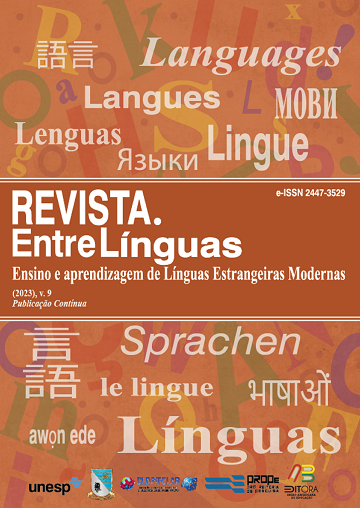Comprender la imagen de una serpiente en diferentes cuadros lingüísticos y culturales del mundo
DOI:
https://doi.org/10.29051/el.v9i00.17881Palabras clave:
Unidad fraseológica, Imagen lingüística del mundo, SerpienteResumen
El artículo analiza expresiones idiomáticas que funcionan en la lengua de diferentes pueblos (Rusia, China, etc.). El análisis de unidades fraseológicas ayuda a comprender la cosmovisión y la percepción de la realidad circundante por parte de una nación en particular. La originalidad de la imagen lingüística del mundo se forma sobre la base del idioma de cada nación por separado, y es el estudio de las expresiones idiomáticas lo que contribuye al conocimiento de esta imagen lingüística del mundo de un pueblo en particular. Debido al hecho de que la vida humana y el mundo animal están estrechamente entrelazados e interrelacionados, es el estudio de los zoónimos utilizados en unidades fraseológicas lo que ayuda a explorar y comprender mejor la cultura de los diferentes pueblos. Además, son los zoónimos los que se usan con mayor frecuencia en el fondo fraseológico de cualquier idioma, ya que el folclore (proverbios, refranes) es la fuente principal que repone los idiomas con modismos. Este artículo examina la imagen de una serpiente, que funciona en las unidades fraseológicas de diferentes pueblos, el análisis de esta imagen permitió revelar que en la imagen lingüística del mundo, diferentes pueblos han formado una actitud ambivalente hacia esta imagen.
Descargas
Citas
ASKAROVICH, H. A.; KHUDOYBERDIYEVNA, S. Z. Emotional concepts in English and Russian phraseology. Conferencious Online, p. 33-37. 2021.
BAIRD, A. et al. Child readers and the worlds of the picture book. Children's Literature in Education, v. 47, n. 1, p. 1-17. 2016.
BALTABAEVA, G. K. Phraseological units of English, Russian, Uzbek and Karakalpak languages. In: E Conference Zone, p. 1-5, Oct. 2022.
JUMAYEVA, Z. Linguo-culturological features of zoonimic phraseological units in Uzbek and Russian languages. Theoretical & Applied Science, n. 4, p. 720-723, 2020.
KHUDOYBERDIEVNA, S. Z. Analysis of the concepts of emotions in Russian and English phraseological picture of the world. Pindus Journal of Culture, Literature, and ELT, v. 2, p. 11-18, 2021.
OKHRIMENKO, V. et al. Psycholinguistic mechanisms of expression emotion to denote disgust in phraseological pictures of the world in different languages. Journal of Language and Linguistic Studies, v. 18, n. 2, p. 1088-1095, 2022.
POLIKARPOV, A. M. et al. A Linguosemiotic Study of Nominations of Northern Lights in Russian and German. Social and economic development, n. 46, p. 192-210, 2022.
TORRICO, D. D. et al. Images and chocolate stimuli affect physiological and affective responses of consumers: A cross-cultural study. Food Quality and Preference, v. 65, p. 60-71, 2018.
TRAFÍ-PRATS, L. Learning with children, trees, and art: For a compositionist visual art-based research. Studies in Art Education, v. 58, n. 4, p. 325-334, 2017.
TURAPOVA, N. Non-equivalent phraseological units as a “Lifemirror” of the people (On the example of Japanese and uzbek languages). Academicia: an international multidisciplinary research journal, v. 11, n. 1, p. 125-133, 2021.
WAHEDI, N. Thematic classification of religiously-marked phraseological units. Philology matters, n. 1, p. 81-90, 2019.
WORTH, S. Studying visual communication. University of Pennsylvania Press, 2016.
Descargas
Publicado
Cómo citar
Número
Sección
Licencia

Esta obra está bajo una licencia internacional Creative Commons Atribución-NoComercial-CompartirIgual 4.0.
Os manuscritos aceitos e publicados são de propriedade da Revista EntreLínguas. Os artigos publicados e as referências citadas na Revista EntreLínguas são de inteira responsabilidade de seus autores.
Transferência de direitos autorais – autorização para publicação
Caso o artigo submetido seja aprovado para publicação, já fica acordado que o(s) autor(es) autoriza(m) a UNESP a reproduzi-lo e publicá-lo na EntreLínguas, entendendo-se os termos “reprodução” e “publicação” conforme definição respectivamente dos incisos VI e I do artigo 5° da Lei 9610/98. O artigo poderá ser acessado pela rede mundial de computadores (Internet), sendo permitidas, a título gratuito, a consulta e a reprodução de exemplar do artigo para uso próprio de quem a consulta, desde que haja a citação ao texto consultado. Essa autorização de publicação 328 EntreLínguas, Araraquara, v. 1, n .2, p. 323-328, jul./dez. 2015 não tem limitação de tempo, ficando a UNESP responsável pela manutenção da identificação do(s) autor(es) do artigo. Os artigos publicados e as referências citadas na Revista EntreLínguas são de inteira responsabilidade de seus autores.











